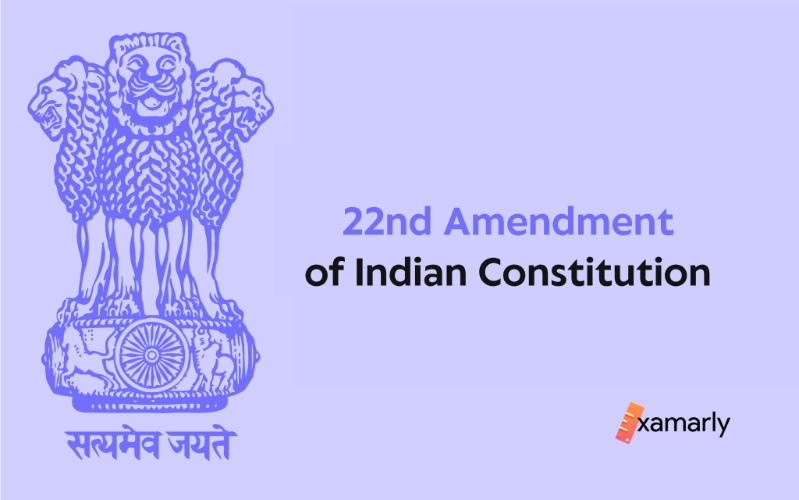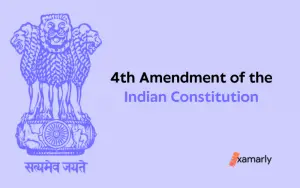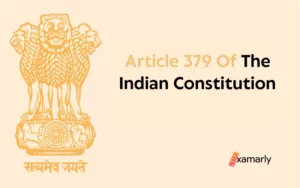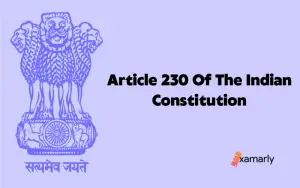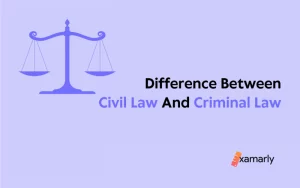On December 10, 1968, the Constitution (Twenty-second Amendment) Bill, 1968, was introduced in the Lok Sabha. Yashwantrao Chavan, who was then the minister of home affairs, introduced it. It also aimed to add more articles 244A and 371B to the Constitution, as well as revise article 275.
This article is a thorough analysis of the 22nd Amendment of the Indian Constitution which will help you from the UPSC point-of-view.
22nd Amendment of Indian Constitution
The Twenty-second Amendment of the Constitution of India is officially termed as The Constitution(Twenty-second Amendment) Act, 1969. A new article 244A was added to the Constitution as a result. The purposes of article was to provide Parliament the authority to pass legislation creating an autonomous State within the State of Assam.
Moreover, as consequential provisions, it grants the autonomous State the legislative authority, ministerial power, or both, as determined by the legislation.
Article 275 was modified by the 22nd Amendment. This was to address the provision with respect to special grants payable due to the autonomous State upon and following its formation under article 244A.
It also established a new article 371B that described the structure and responsibilities of an Assam Legislative Assembly committee. It was made up of members of that Assembly chosen from the tribes listed in Part A of the Table that is annexed to Paragraph 20 of the Sixth Schedule, along with any other members of that Assembly that may have been included in the order.
You might also like to read about: Schedules of The Indian Constitution.
Statement of Objects and Reasons
The broad details to create an autonomous state inside the State of Assam were presented by the Government of India on September 11, 1968. This state will reportedly include some of the territories indicated in Part A of the chart appended to Paragraph 20 of the Constitution’s Sixth Schedule.
The Bill’s second clause aims to add a new article 244A to the Constitution. This was done to grant Parliament the required legislative power to approve legislation creating the autonomous State. Moreover, it provides the autonomous State with a legislature and a council of ministers, each with the authority and responsibilities set by the relevant law.
Article 275 of the Bill makes consequential amendments concerning the exceptional grants under Clause 3 of the Bill. These grants are owed to the Government of Assam in respect of potential autonomous State territory.
The constitution of a committee of the Assam Legislative Assembly is mandated by Clause 4 of the proposed law. Members of this committee include a few more Assembly members as well as representatives from the aforementioned tribal territories.
If you want to know more about the states of India, check our blogs on the following topics:
- Administrative Relations Between Centre and State.
- States and Union Territories of India.
- States and Capitals of India.
Facts and Features
| Who introduced the Amendment? | Yashwantrao Balwantrao Chavan. |
| When was it introduced? | In the Lok Sabha on 10 December 1968. |
| The official name of the Amendment: | The Constitution (Twenty-second Amendment) Act, 1969. |
| Which articles were inserted? | Articles 244A and 371B. |
| Which article was amended? | Article 275. |
3 Major Provisions under the 22nd Amendment
1. Insertion of New Article 244A
Article 244 shall be followed by the following article in Part X of the Constitution.
244A. Creation of a local legislature, a council of ministers, or both to create an autonomous state made up of some Assam tribal districts.
- Parliament of India has the power to enact laws to establish an independent state within the State of Assam without denying any Constitutional requirements. This encompasses all or some of the tribal territory indicated in Part A of the table attached to paragraph 20 of the Sixth Schedule. This may be done by:
- (a) a body that serves as the Legislature for the autonomous State, whether it is elected or partially nominated and elected, or
- (b) a Council of Ministers, or both, with the constitution, authority, and responsibilities, in each case, that may be defined by law.
- Any law referred to in clause (1) may, in particular—
- (a) list the things that are currently on the State List or Concurrent List that declares the independent State’s legislature will have the power to adopt laws for the complete, or in respect to any portion of, whether with or without the State of Assam’s legislative’s agreement;
- (b) specify the matters concerning which the independent State’s executive power shall be extended;
- (c) declaring that any taxes collected by the State of Assam should be transferred to the autonomous State to the extent that the earnings thereof are attributable to the autonomous State;
- (d) allow for the autonomous State to be referred to whenever a State is mentioned in any article of this Constitution; and
- Any of the aforementioned laws may be modified. However, insofar as the modification relates to any of the subjects named in Subclauses (a) or (b) of Clause (2), it will not go into effect unless it is agreed by not less than two-thirds of the members present and voting in each House of Parliament.
- Any law referred to in this article must not be considered such for article 368, even if it contains provisions that amends or affects this Constitution.
Read Also: Article 243 & Article 245 of the Indian Constitution.
2. Amendment of Article 275
The following clause shall be added to Article 275 of the Constitution after Clause (1), namely:
- (1A) When the autonomous State is formed by article 244A—
- (i) Any amounts payable under Clause (a) of the second proviso to Clause (1) shall be paid to the autonomous State if it includes all of the tribal areas mentioned therein. Additionally to the State of Assam if it includes only some of those tribal areas, according to any allocation the President may specify by order;
- (ii) Amounts, both capital and recurring, equal to the expenses of any development programmes that the autonomous State may undertake with the Government of India’s consent in order to bring its administration up to par with that of the rest of the Assam State, will be provided out of the Consolidated Fund of India as a grant-in-aid to that State.
You might also like to read about:
3. Insertion of New Article 371B
The following article shall be introduced after Article 371A of the Constitution:
371B. Special Provision concerning the State of Assam.
- The President may issue an order regarding the State of Assam that goes against what is written in this Constitution. Specifying the membership and responsibilities of a committee of the Legislative Assembly of the State, which shall be made up of members of that Assembly elected from the tribal areas listed in Part A of the table attached to paragraph 20 of the Sixth Schedule and such additional members of that Assembly as may be specified in the order.
Also Read: Article 370 and Article 372 of the Indian Constitution.
Ratification
The Act was passed under the requirements of Article 368 of the Constitution. Additionally, as required by Clause (2) of the aforementioned article, it was approved by more than half of the state legislatures.
The legislatures of many states, including Assam, Kerala, Madhya Pradesh, Nagaland, Mysore, and others, ratified the amendment. The amendment was not ratified by Andhra Pradesh, Bihar, Jammu and Kashmir, Orissa, and Punjab.
Read also about the previous amendment: 21st Amendment of Indian Constitution.
Summary
The Constitution(Twenty-second Amendment) Act, 1969 is the formal name of the twenty-second amendment to the Indian Constitution.
On December 10, 1968, Yashwantrao Chavan presented the Constitution (Twenty-second Amendment) Bill, 1968, in the Lok Sabha. It aimed to change Article 275 and add Articles 244A and 371B.
Read about the next amendment: 23rd Amendment of Indian Constitution.
FAQs on 22nd Amendment of Indian Constitution
What was the aim of the 22nd amendment of Indian Constitution?
the 22nd amendment aimed at inserting new articles 244A & 371B while amending article 275 to the Constitution of India with special regards to the State of Assam.
What is the process to amend the Constitution of India?
The procedure to amend the Constitution of India involves passing a bill in both houses of parliament and ratification by half the state legislatures. Once this is done, the bill is presented to the President for assent.
Is Assam an autonomous state?
Assam is not an autonomous state, but it does have some autonomous councils that have been established to provide for the local administration of certain areas. The two main autonomous councils in Assam are the Bodoland Territorial Council and the Karbi Anglong Autonomous Council.
These councils have some degree of administrative and legislative authority over their respective areas, which allows for greater local control and decision-making. However, they still operate under the overall framework of the Indian Constitution and are subject to the authority of the central government.
What are the special grants given to the state of Assam?
The central government of India provides various special grants to the state of Assam for the purposes of development, infrastructure, and other priority areas. Some of the special grants provided to Assam include:
1. North East Special Infrastructure Development Scheme (NESIDS): This is a central government scheme that provides funding for infrastructure development in the northeastern states, including Assam. The scheme focuses on the development of physical infrastructure, including roads, bridges, water supply, and power infrastructure.
2. Special Category Status: Assam, along with some other northeastern states, has been granted special category status by the central government. This allows for higher levels of funding and assistance for development projects in the state.
3. Assistance for Flood and Erosion Control: Assam is prone to floods and erosion, and the central government provides financial assistance to the state for the construction of flood control and erosion management infrastructure.
4. Assistance for Tribal Development: Assam has a significant population of tribal communities, and the central government provides financial assistance to the state for the development of tribal areas and the improvement of the living standards of tribal communities.
5. Assistance for Skill Development: The central government provides funding for various skill development programs in Assam to improve the employability of its people and promote economic growth.
These are just a few examples of the special grants and assistance provided by the central government to the state of Assam.
What is the constitution of Assam state legislative assembly?
The Assam State Legislative Assembly consists of a total of 126 members, with 119 members elected by the people and one member nominated by the Governor. The Speaker of the Assembly is also a member of the House.


